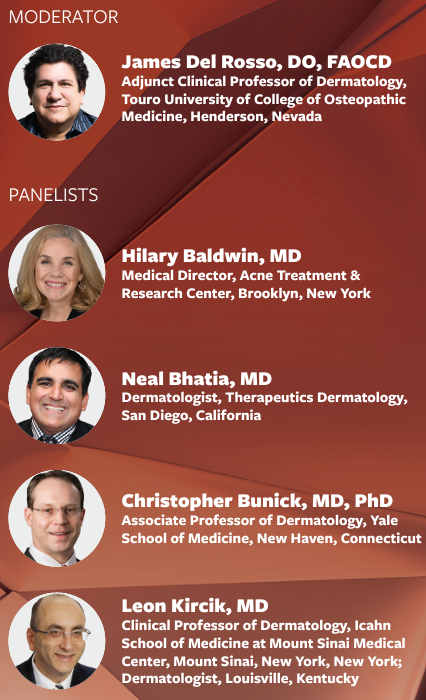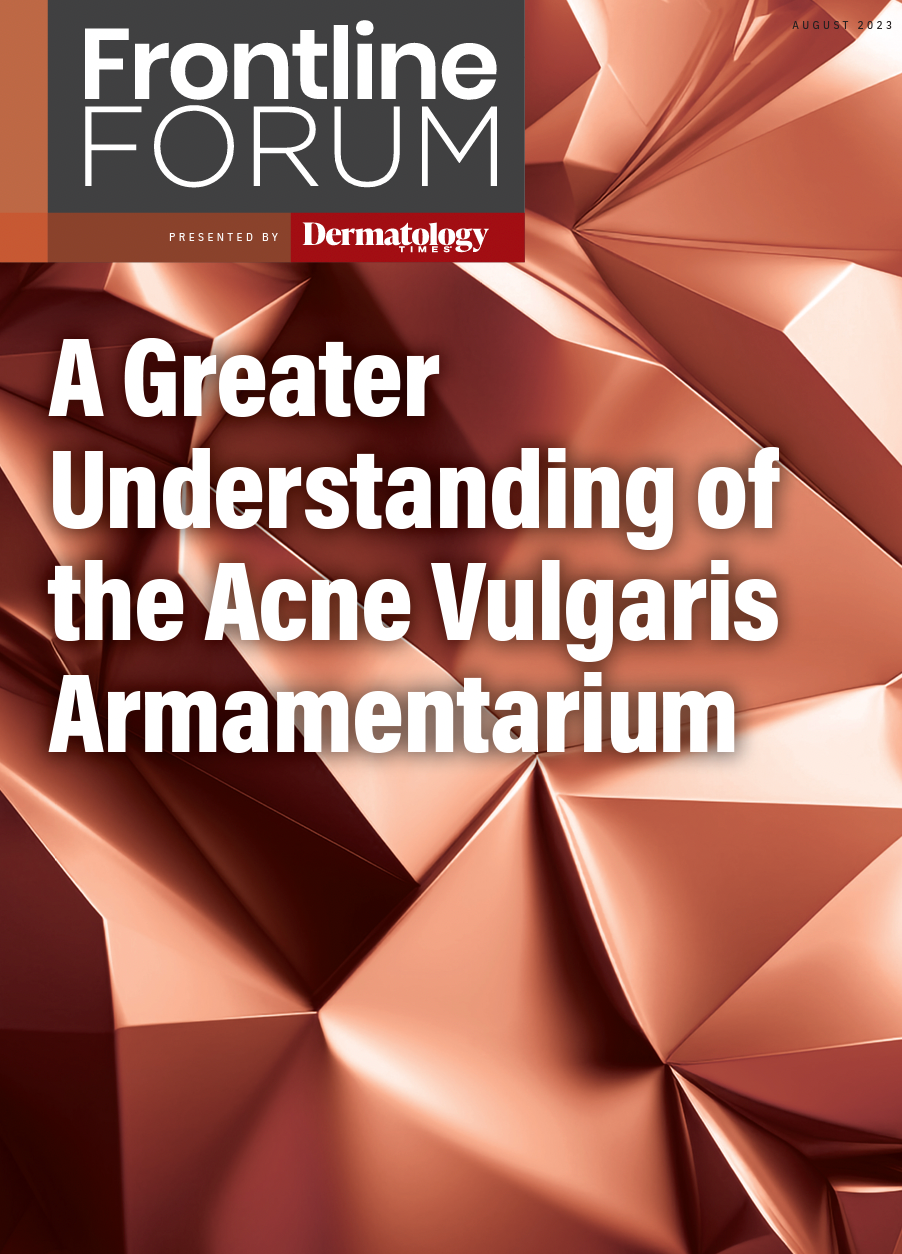- Case-Based Roundtable
- General Dermatology
- Eczema
- Chronic Hand Eczema
- Alopecia
- Aesthetics
- Vitiligo
- COVID-19
- Actinic Keratosis
- Precision Medicine and Biologics
- Rare Disease
- Wound Care
- Rosacea
- Psoriasis
- Psoriatic Arthritis
- Atopic Dermatitis
- Melasma
- NP and PA
- Skin Cancer
- Hidradenitis Suppurativa
- Drug Watch
- Pigmentary Disorders
- Acne
- Pediatric Dermatology
- Practice Management
- Prurigo Nodularis
- Buy-and-Bill
Publication
Article
Dermatology Times
Frontline Forum Part 2: A Greater Understanding of the Acne Vulgaris Armamentarium
Author(s):
In part 2 of this Frontline Forum series, James Del Rosso, DO; Hilary Baldwin, MD; Neal Bhatia, MD; Christopher Bunick, MD, PhD; and Leon Kircik, MD, discuss the use of clascoterone cream 1%, differences in isotretinoin formulations, targeting sebum production, acne guidelines for patient care, and more.

The panelists also discussed the importance of considering potential interactions between individual therapies when they are combined because they may not be as effective as when they are given as monotherapy. “Putting 2…agents one on top of [the other], even though it’s convenient for the patient, may not [yield] the same efficacy,” said Kircik. “We don’t know if they are stable together or not. Still, most of the providers don’t understand the fact that [if] you put one on top of [the other], you [may not have] 100% efficacy.”
Knowing the patient’s routine and lifestyle and counseling them on the appropriate timing and sequence of application are also important when prescribing multiple medications, and Baldwin typically budgets 30 minutes for an initial acne visit to go over these topics with patients. The panelists added that they (and, likely, the majority of other clinicians who treat acne) do not rely on the treatment recommendations from clinical practice guidelines because they introduce a mandate for step therapy, often do not include the latest therapies, and are frequently created by individuals who are not in clinical practice.
“As clinicians practice the art of medicine, [they] develop [their] own internal guidelines based on experience, and that guides how you treat your patients based on what you’ve observed [over time],” said Bunick.
For example, hormonal therapy is listed as an alternative treatment option for moderate or severe AV in the American Academy of Dermatology Clinical Guidelines, but many of the panelists would consider it as a first-line treatment option in certain cases.1 Additionally, Baldwin said that the guidelines generally include minimal discussion about the irritation associated with retinoids and the difference in irritation among the various retinoid vehicles. Bunick added that using hormonal therapies such as dapsone or clascoterone with a retinoid often results in less dryness and irritation—and in turn, better patient adherence—than a combination regimen BP, an antibiotic, and a retinoid. Hormonal therapies such as dapsone and clascoterone may also help promote antibiotic stewardship and reduce the risk for future development of antibiotic resistance in patients with mild or moderate AV.
“I really try to find a regimen that’s going to be tolerable because I know [that] if I can gain [the patient’s] trust, I’m going to have better success [with patient adherence],” said Bunick. “First-line treatment has to consider regimens that [take] into account the patient experience.”
When developing a treatment strategy, the panelists often categorize patients by whether they should be treated with a topical-only regimen, combination of topical and oral medications, or isotretinoin, which the panelists generally consider for “very severe” AV. However, the severity of AV is often dynamic, and Del Rosso said that he treats patients as if the severity of the AV is 25% to 30% greater than what he observes upon initial presentation to account for this fluctuation. Baldwin added, “One of the most important questions to ask [during a patient’s] visit is, ‘Is this a good day? Or a bad day?’ Because if it’s a bad day, you can treat accordingly. If it’s a good day, then you have to figure out what a bad day looks like.”
Bunick reassesses patients every 3 months to determine whether the treatment regimen is working and relies on the patient’s reported quality of life to make the decision to continue or change the treatment regimen. He continues to tweak the regimen even in cases when there are objective improvements but the patient is still not satisfied.

“If they’re not happy, that means that’s affecting their school, that’s affecting their work, it’s affecting their relationships,” he said. “We’re treating the whole patient, not just their skin. Acne and mental health and quality of life all go together.”
However, Del Rosso noted that patients may have significant improvements even if they still see residual dyschromias, and he tells them to measure improvements by feeling for the raised lesions on their face with their eyes closed. Baldwin added that practitioners should let patients comment first on their perceived progress, rather than initiating comments about their appearance.
Looking for a Novel Mechanism of Action
Excess sebum production in AV has been targeted with hormonal therapies because sebocytes inside the sebaceous gland produce dihydrotestosterone (DHT) and other androgens, which bind to and create complexes with the androgen receptor.4 These complexes translocate to the nucleus, where they upregulate transcription of genes involved in production of sebum and inflammatory cytokines.4
Clascoterone cream is an androgen receptor inhibitor that has a unique mechanism of action for treatment of AV and can be used in both men and women.4 In preclinical studies, clascoterone was shown to compete with other androgens, particularly DHT, for binding to androgen receptors in the skin.4 This inhibition of DHT binding to the androgen receptors downregulates signaling of pathways that promote acne development and decreases transcription of androgen-responsive genes, leading to decreased sebum production and diminished activation of inflammatory pathways.4 Unlike oral hormonal agents used for AV, clascoterone activity is limited to the androgen receptors at the application site and is subsequently broken down to an inactive form, which minimizes systemic effects.4
“The oral medications are suppressing the circulating levels of androgens, but [clascoterone] is getting right into the sebaceous gland,” said Baldwin. “It’s almost as if it doesn’t matter what the circulating androgens are; it’s decreasing production within the sebaceous gland, which is where you want it to be. It’s what allows this [agent] to be used in men and what makes it safe in people of all ages.”
Disclosure
This Frontline Forum is supported by Sun Pharmaceutical Industries Ltd.
References
1. Zaenglein AL, Pathy AL, Schlosser BJ, et al. Guidelines of care for the management of acne vulgaris (published correction appears in J Am Acad Dermatol. 2020 Jun;82(6):1576. J Am Acad Dermatol. 2016;74(5):945-973.e33. doi:10.1016/j.jaad.2015.12.037
4. Hebert A, Thiboutot D, Stein Gold L, et al. Efficacy and safety of topical clascoterone cream, 1%, for treatment in patients with facial acne: two phase 3 randomized clinical trials. JAMA Dermatol. 2020;156(6):621-630. doi:10.1001/jamadermatol.2020.0465






